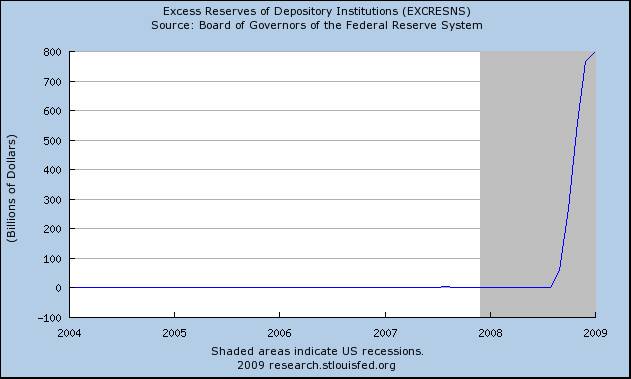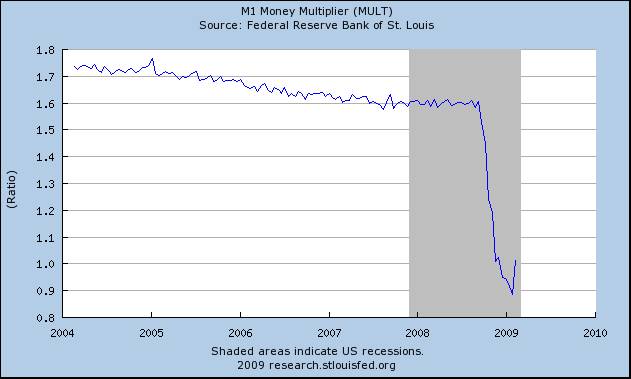Indicators for Trading in Government Bond ETFs
U.S. Government Bond ETFs Thrive as Economy Gasps for Air
Exchange-traded funds (ETFs) that invest in U.S. Government bonds — like the ^TLT^ — thrive during economic recessions because investors flock to pull their money out of the stock market and into U.S. Treasuries. The increased demand for Treasuries boosts their value, which boosts the value of the ETFs.
The question is, what indicators should you watch to help you determine not only when to get into U.S. Government bond ETFs but also when to get out of them? Let’s take a look.
When Banks Hoard Cash, Money Doesn’t Flow
Cash is the lifeblood of any economy, and when cash stops flowing, recession is right around the corner. We have seen this phenomenon in spades during this most recent recession, and the government is doing everything it can think of to alleviate the problem. The Federal Reserve and the U.S. Treasury are pumping billions and billions of dollars into the financial system to try and ease the credit crisis. Unfortunately, there’s a little hiccup in the system — banks aren’t pushing the money through the system by lending it out.
When banks won’t lend out the money they have been given, there is no way for that money to multiply in the fractional-reserve banking system. And if the money doesn’t multiply in the fractional-reserve banking system, there is simply not enough money to pull us out of this recession.
After all, if businesses and consumers can’t get access to money via credit, they can’t spend it.
The Multiplier Effect of Money
The fractional-reserve banking system allows money to multiply on top of itself. Here’s how it works:
When banks receive money on deposit, they are only required to keep 10 percent of that money on reserve. They are free to lend the other 90 percent out to other individuals and institutions.
So if someone deposits $10,000 at a bank, the bank is then able to take that $10,000 and lend $9,000 ($10,000 x 0.9 = $9,000) of it out to someone else while keeping $1,000 ($10,000 x 0.1 = $1,000) of it on reserve.
In essence, the bank magically turns $10,000 into $19,000 — thanks to the fractional-reserve banking system.
Banks are Hoarding
The fractional-reserve banking system only works if banks are lending money. If deposits are coming in but loans aren’t going out, the money supply can’t grow — which is exactly what is happening.
According to the Federal Reserve, banks are hoarding cash. As you can see in this chart, banks currently have nearly $800 billion in excess reserves when they had virtually $0 in excess reserves at the beginning of 2008.

The Money Multiplier is Crashing
The excessive bank hoarding is choking the monetary system. As you can see in this chart, the monetary system had a healthy multiplier effect of approximately 1.6 (160 percent) at the beginning of 2008. However, the multiplier effect actually dropped below 1.0 (100 percent) at the beginning of 2009. This means the monetary base was actually contracting.

Until banks stop hoarding cash and money is able to multiply in the marketplace once again, the economy will continue to stagnate—which means it is a great time to be in ETFs that buy U.S. Treasuries. This is true not only during the recession that began in 2008 but also for any future recession. Sure, each recession has unique characteristics, but every recession sees investors flocking to the safety of U.S. Treasuries.
However, you need to keep you eye on these indicators for signs of recovery. If banks start lowering the amount of money they are keeping on reserve and the money multiplier effect starts to grow again, you may want to consider selling your U.S. Treasury backed ETFs and moving your money back into stocks and other investments.
You may also want to consider buying a short U.S. Government bond fund — the ^SHV^ — which will increase in value as the value of U.S. Treasuries contract.
S. Wade Hansen is a founder of LearningMarkets.com and PFXGlobal.com. He is also the co-author of Profiting With Forex, a popular currency investing book. His commentary is featured on financial sites across the web.
Click here to sign up for a free, online presentation by Larry Connors, CEO and founder of TradingMarkets, as he introduces The Machine, the first and only financial software that allows traders and investors to design and build quantified portfolios.
